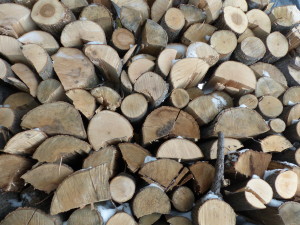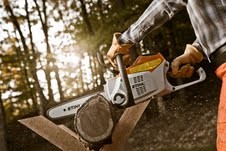Every once in a while every homeowners needs to cut wood. Hedges overgrow. Branches break and land in the driveway. Trees need pruning. And sometimes firewood must be cut.
There’s been a recent evolution in saws that helps homeowners manage trees and shrubs. Muscle powered types have been around for years. Gasoline chainsaws appeared in the 1950s and keep improving in ease of use, safety and efficiency. Recently, cordless electric saws entered the market. Each type saw has strong benefits and some drawbacks.
USING MUSCLES
If you just need to cut a few fallen branches, don’t buy an inexpensive chainsaw at a big box store. For small jobs a sharp muscle powered saw is often best.
Here are some advantages:
- Much less expensive than a chainsaw.
- No need for gasoline. Human power works and yields exercise!
- No noisy motor to barrage the air or break down.
- Need little storage space and last for years.
- Blade can be re-sharpened or replaced on a bow saw.
Here is one disadvantage:
- Although generally safe, they can inflict a nasty cut.
Two types of commonly available muscle powered saws are useful in the yard.
Bow saws look alittle like an old fashioned bow without the arrow. A tubular steel frame forms the bow and a replaceable blade is the “string”. They come in sizes based on blade length from 12” to 36”. Medium sized ones are best for most backyard chores. Bow saws are ideal for cutting fallen branches into firewood. A sharp one slices through a three inch diameter branch with ease. The downside of bow saws is their somewhat ragged cut. That’s hardly a problem with firewood, but a clean cut is important when pruning living trees. That’s where a pruning saw shines.
Pruning Saws look somewhat like carpenter’s hand saws but normally have larger teeth and sometimes a curved blade. They are designed to cut cleanly with little tearing so the tree heals easily.
Muscle powered saws are efficient IF THEY ARE WELL DESIGNED AND SHARP. Buy a quality saw and keep it sharp. Store it in a in a dry place where it won’t rust. For long term storage, for example over winter, put a light coating of oil on the blade to reduce odds of rusting.
A SHORT PRIMER ON CHAINSAWS
Chainsaws come into their own when lots of wood needs to be cut, especially if it is of large diameter.
Early model saws from the 1970s and earlier were heavy, noisy and vibrated severally. But, newer ones are easier and more comfortable to use. They also incorporate safety features lacking on old timers.
A chainsaw’s cutting teeth zip along at about 60 miles per hour. Every tooth passes the same spot on the bar about 20 times a second! When properly sharpened they roar through wood but can do instant and major damage to human flesh.
Using a chain saw properly and safety takes skill. Even the most experienced operators wear safety equipment and always remember to work safely. Too many people who have never used a chainsaw buy one, rev it up and begin cutting without getting proper training or using proper safety equipment. BE SAFE!
Chainsaws range from small lightweight inexpensive homeowner models to heavy powerful logging machines. A motor powers a sprocket that drives a tooth studded chain round a “bar”. Most bars range from 14 to 20 inches. Saws squirt oil from a small tank into the chain to reduce friction and heat.
Buying A Chain Saw: Most chainsaws sold by big box stores are, essentially, throw away models. They are inexpensive and fine for small infrequent use, but for long term durability, ease of use and repair, invest in a quality saw. Before you buy ask if the store has a repair department. If not buy your saw somewhere else. Quality saws are sold at specialty stores that also sell safety equipment, spare parts and maintenance supplies. Chances are the sales person is a seasoned saw operator who will coach a buyer on operating the saw, safety and maintenance.
Remember those cutting teeth go 60 miles an hour! BE SAFE. Always wear ear, head and eye protection, leather gloves, leather boots and saw chaps. Safety equipment can’t prevent all accidents but it can help reduce injury should something go wrong. About 40% of chainsaw injuries are to the legs. Chaps are like an apron made of materials designed to slow or stop a chain should it impact a leg.
Saws are noisy and can permanently damage hearing. Muffs that fit over the ears or small plugs that fit inside ears are essential. Some people choose to wear both types of hearing protection at the same time for ultimate noise reduction. Safety glasses help protect eyes from debris that sometimes flies off the saw.
Head injuries account for about half of chainsaw deaths! Wearing a stout hard hat reduces odds of a head injury. Some operators use a hard hat that has a face shield and ear muffs attached.
ALWAYS BE SAFE. Some other safety tips include:
- Have a first aid kit and cell phone handy.
- Regularly inspect safety equipment. Replace anything that seems faulty.
- Keep the saw sharp and well maintained
- Take breaks to ward off fatigue.
- Saw when others know you are sawing and can help if needed.
- Check the chain brake before starting the saw. If it is in the forward position the chain should be locked and not move.
Chainsaws are potentially dangerous. Using one efficiently and safely is a high skill that comes with a learning curve. In some areas chain saw classes are available. Websites, books and You Tube videos help a novice learn saw techniques and safety. Watch and read before starting the saw! Videos and books can also help a novice learn how to properly sharpen their saw’s teeth.
Probably the best way to learn saw operation and maintenance is to find an experienced mentor and spend time working with him or her.
ALWAYS BE SAFE. Many scenarios can lead to chain saw accidents but two are too common.
One is haste. It’s tempting to fire up the saw without donning safety equipment and hurriedly work when there’s only a branch or two to cut. Always don safety equipment and take your time. The second scenario is fatigue. Wood cutting is hard work and wise experienced loggers in superb physical condition recognize when they are getting tired and take a break.
Employees of the U.S. Forest Service often use chain saws. A standard greeting between two of their staff isn’t to say, “Hi” or “goodbye”. They say “BE SAFE”!
| One gorgeous summer morning high in Idaho’s mountains I witnessed a serious chain saw accident that could have been completely prevented. Our crew was all seasoned operators and typically we took a mid-morning break to rest and sharpen saws. We were on an old logging road and one of our crew was sharpening his saw. We heard a yell and looked over to see him clutching his hand. Blood curled down his forearm from a deep cut on his palm. A crew member applied pressure, put on several layers of gauze, and taped it tightly. I was appointed to drive him to the nearest hospital, which was an hour distant. The doctor sewed the cut shut.The cut happened when his hand slipped while filing a tooth. The saw was not even running. Had he worn leather gloves there might have been a cut glove but an uninjured hand. LESSON: Wear leather gloves, even when sharpening a saw. |
Wood carefully cut, split and stacked.
BATTERY AND ELECTRIC CHAIN SAWS
In recent years many new types of electric saws have entered the market. Most corded models are designed for light work, not cutting many cords of firewood. They are lightweight, generally less expensive than gas saws, quiet, cut well and need no gas, although they require oil to lubricate the chain. Their downside is the tether, so they are only useful near an electric outlet.
Cordless electric chainsaws saws are powered by a lithium ion battery. They are amazing machines that merge many of the benefits of gas and corded saws. Stihl and other companies sell a wide range of yard maintenance tools that operate on the same battery as the chain saw. This allows for flexibility.
Quality battery operated saws allow plenty of cutting on one charge, but for long time use it’s wise to have two batteries. When one is in use the other is on the charger. Stihl claims that a fully charged battery gives about 35 minutes of trigger time and takes about 25 minutes to recharge.
BE SAFE: SAFETY PRECAUTIONS FOR GAS SAWS APPLY TO ELECTRIC AND BATTERY MODELS
WINDING PATHWAYS AND SAWS
Winding Pathways co-owner Rich Patterson began using chain saws in 1974 when he logged on Idaho’s Boise National Forest. He had the good fortune to be mentored by several experienced saw operators. For four months he cut down huge trees and bucked them into lengths. Since then he’s used dozens of saws for firewood cutting, tidying up his yard and for removing fallen trees from trails and ecological restoration at two nature centers where he served as executive director. Over the years he has taught many people safe and effective saw use and he’s purchased and used chainsaws of many brands and configurations.
STIHL COMPANY PROFILE
by Rich Patterson
About a dozen years ago I used my first Stihl chainsaw and now that is the only brand I use. My current Stihl 290 is about eight years old and has cut over 60 cords of firewood. It’s
reliable, solid, easy to maintain and fixable. Only one time did I have a minor problem with it. At the store where I bought it, the staff looked it over the saw and had it running smoothly in just a few minutes.
The Stihl Company was founded by inventor Andreas Stihl in 1926 in Germany. It came came to the United States in 1974 and today makes a wide range of handy tools for managing trees, turf and other functions. Most are made in Virginia Beach, Virginia, with many components made in the United States.
Stihl’s website, www.stihlusa.com, is an amazing resource. It includes videos and articles that help teach how to start, safely use, sharpen and maintain saws and other equipment. There’s even a link to help identify tree species. The site offers excellent education and technical information about equipment.
The Internet is an outstanding resource for information on the use and care of equipment and wood characteristics among other topics. Just remember that Internet videos and blogs are only as good as the person who or company that produced them.
Be Safe and happy cutting!



